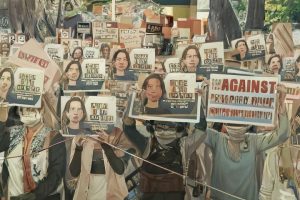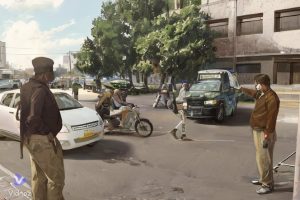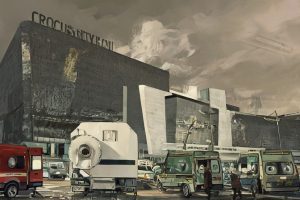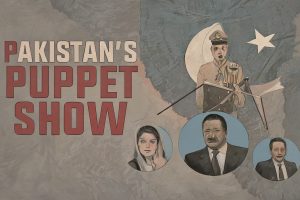Malaysia can be a good case study for Pakistan from which Pakistan can learn lessons on ethnic harmony and economic development
By Dr. Minhaj Qidwai
Pakistan and Malaysia both were liberated from the Britishers. Pakistan earlier than Malaysia. Malaysia has a concept of statehood, while Pakistan’s creation as a state has outpaced the creation of nation. Islam (as a political and ideological force) was the so-called binding element which united the Eastern and Western parts. After the separation of East Pakistan, the unifying capability of the Islamic ideology became questionable. Ethnic nationalism laid the foundation of division of Pakistan and threatens its further division. The new Pakistan after 1971 was politically bifurcated on ethnic lines. Later on, the military-bureaucratic establishment over-centralized the State structure of Pakistan, which resulted in the political polarization of Pakistani society. Against this background, Malaysia can be a good case study for Pakistan from which Pakistan can learn lessons on ethnic harmony and economic development.
However, what has made Malaysia to prosper compared to that of misery Pakistan is facing? Following factors may be considered:
Ethnicity
Malaysia is a good example of a multi-ethnic and multi-racial state that promotes ethnic harmony, communal peace and rapid economic progress. After progressively passing through the process of state building and nation building, Malaysia has been classified as an upper middle income developing country. Pakistan is also a multi-ethnic, multi-cultural state, but since independence, it has faced ethnic and ideological problems which have resulted in economic turmoil and political instability.
As we have in Pakistan the locals outnumbering the migrants, same we have in Malaysia. The locals called as Bumiputra constitutes around 65% with majority being Malayans, followed by the Chinese 25 per cent, Indians 7.0 per cent, others 3 per cent. During the struggle for independence unity was a problem because of the people’s differences in background, origin, culture, religion and language. Ethnic minority groups had strong reservations against the majority. Every party had its own objectives and ideology and parties based their politics on race and ethnicity. But in spite of this all communities joined the same cause and that was to oppose the establishment of the British-sponsored Federation of Malaya and to fight for the country’s independence. In case of Pakistan, despite of the differences the religion became the driving force for achieving independence from the British. This was coupled with the leadership of Quaid, the British exit and their need to create a buffer state in the region to prevent Russian access to warm waters.
People of Malaysia
Malaysians are very humble and polite. The Muslim females wear the traditional hijab, while the non-Muslims do not. All the ethnicities have equal rights of worship at their places of worship. The business growth mostly owes to the Chinese population who are hardworking and professionals. Sporadic minority and immigrant population could also be witnessed in business. The Muslims run the local government. Islam came in Malaysia in around 1500 and they follow Imam Shafaii. No threat of Islamic sectarianism was seen throughout. It is a pity to see Pakistan facing with Islamic divisions among themselves, resulting in regular clashes among the followers and no end in sight.
State to State Comparison
Malaysia is a wonderful blend of traditional and modern urban metropolises nestled in lush and fertile countryside. Moreover, it is a showcase of natural as well as cultural diversities like Pakistan. There are many similarities between the two countries: first, both were former colonies of the British Empire; second, Islam is the dominant religion; third, both countries practice the parliamentary form of democracy. The flags of both countries have a star and a crescent which are the symbols of Islam. Centuries of shared history, culture, beliefs and values unite Pakistan and Malaysia
Economic Development of Malaysia
Malaysian economic growth in 1990 reached the rate of 10 per cent, the highest in South East Asia. The secret of Mahathir’s success:
a. At the economic front, he focused on rapid growth and development to increase the size of the economic pie, thus relieving tensions between the ethnic communities as well as within the Malay community.
b. In the political front, he used the Islamic ideology as a potential tool for State authority. He knew that Islamism had a strong social base in Malay society. He utilized Islam as a means to pursue capitalist development.
c. Additionally, Mahathir argued that a moderately Islamic and a stable State could provide ethnic peace. Non-Malays accepted moderate Islamism as necessary to contain radical Islamism.
d. Mahathir put forward the same argument regarding foreign investment, which was the crux of Mahathir’s growth strategy. He suggested that foreign investment had to be in accordance with Islam.
Mahathir was perhaps the first leader who fully conceptualized the meaning and potential of reinventing the secular post-colonial State into an Islamic state. His policies like “Look East and buy British last”, a criticism of Western values and imperialism, had given him strong support from the Islamic constituencies. Malaysia was then the world’s largest exporter of components assembled and tested mainly in electronics and then mainly for American firms. Expectedly, Islamic activism against foreign investment damaged Malaysia’s international image. In order to contain religious forces Mahathir co-opted Anwar Ibrahim, the leading light of the Islamic Youth movement. This supplied Islamic legitimacy and provided it with intellectual and organizational tools to control Islam. Moreover, Anwar Ibrahim’s most important contribution to the State was to legitimize the conceptual foundations of Mahathir’s Islamization initiative. The Islamization period in Malaysia lasted for two decades (1979-97).
Lacking a strong ideology, State leaders used Islam as a tool to control the State and society. Islamization was not so much about Islam as it was about the State. The State controlled Islamic radicalism by initiating its own brand of Islam. Moreover, Islamization served the State’s goal of economic growth and development. In the political front, the State successfully divided Islamist forces and co-opted some of them. Islamization in Malaysia produced a strong ruling party and state institutions whose interaction and cooperation ensure state power. Malaysia’s GDP grew by 7.1 per cent in 2004. Private investment also increased in 2004 and all major sectors registered positive growth. Since then Malaysia has not turned back. On the contrary, Pakistan has become totally dependent on funding and donations from international donor agencies. The privatization spree being undertaken by present government will further lead towards pocketing of profits by the favored ones, while leaving the nationals assets at stake.
Unity and national integration in Malaysia
The biggest challenge for any multi-ethnic and multi-racial state is to sustain national unity and promote integration. Malaysia has passed the initial stage of nation building process and has united society on the basis of economic and political participation. However, the process of integration has yet to be achieved. The process of national integration can be analyzed on the basis of five elements. These five elements are:
a. Segregation,
b. Accommodation,
c. Cultural Harmonization,
d. Assimilation, and
e. Amalgamation.
However, the integration was challenging. The 1969 general elections resulted in riots and destroyed the semblance of racial harmony. The riots of 1969 taught Malaysian political leadership many lessons, the most important of which is that poverty must be addressed. Rural poverty at that time was forty per cent. The less fortunate who had been disgruntled over their fate took the opportunity to use the violent situation to express their anger. The government constituted a special committee to formulate a national ideology. The five main objectives were:
1) Achieving greater unity among the people;
2) Maintaining a democratic way of life;
3) Creating a just society in which the nation’s wealth can be engaged in a fair and equitable manner;
4) Ensuring a liberal attitude towards the rich and diverse cultural traditions; and
5) Building a progressive society which shall be oriented towards modern science and technology. In order to achieve these objectives, five principles have been established to guide the actions of individuals and their inter-relationships within groups. These five principles are:
1) Belief in God;
2) Loyalty to King and country;
3) Upholding the Constitution;
4) Rule of law;
5) Decorum and morality.
Adopting the above with focus on educating masses, Malaysia is the most progressive Islamic country. Another step taken towards creating unity and harmony among all was to enact federal holidays for all the ethnic representations in Malaysia. Such efforts have built the nationhood concept among the Malaysians.
If we look into the affairs of Pakistan, as per poet Ibn-e-Insha, there are all ethnic groups present in Pakistan, except Pakistanis. In Pakistan, there has hardly been a national effort to work towards bringing unity among the people and provinces. The five Malaysians principles adopted by its leadership could be role model for Pakistan.
Malaysia’s Vision 2020
This vision is not a concrete policy but a slogan formulated by the government to empower citizens to transform Malaysia into a developed nation. It aims to increase per capita income while respecting diversity of races, religions, historical and cultural backgrounds, customs and values. There were eight challenges behind vision 2020.
1. To create a Malaysian nation that is united and has a common objective,
2. To create a society that is free, peaceful and advanced, confident of its own capabilities, strong in facing problems
3. To create and develop a democratic society that is mature and practices a shared philosophy
4. To create a moral and ethical society with strong religious and spiritual values
5. To create a society that is tolerant, liberal and free to practice its own customs, culture and religion
6. To create a scientific and progressive society that is forward looking and farsighted, and thus able to contribute to the improvement of civilization based on Science and Technology
7. To create a society that is fair in the distribution of national wealth regardless of race
8. To create a prosperous society with a competitive economy
After Mahatir, Abdullah Badawi took charge of the premiership in 2004. He listed three big challenges:
1. Corruption;
2. Economic imbalances along racial lines; and finally,
3. Malaysian mindsets, attitudes and mentality.
In order to eliminate ethnic and religious differences, Abdullah’s government initiated the National Service (NS) program in 2004 which targeted better racial integration. Moreover, it also came up with a compulsory course on ethnic studies being offered in all Malaysian universities. All these efforts show the government’s seriousness regarding ethnic integration and economic development of the country.
Although, all the above looks rosy, but there are still issues of corruption, nepotism and economic growth challenges being faced by Malaysia. However, with the systems in place auto correction is possible.
Pakistan, can learn lessons from Malaysia to be on the road of prosperity, ending its miseries. However, the basic difference being the leadership, nationhood, lack of harmony among the religions and ethnicity; as all these have been the driving force for Malaysia. If we want to follow a progressive Islamic country as a role model, Malaysia is an example. The challenges outlined in the vision 2020 of Malaysia also apply for Pakistan but, in addition threat of Islamic extremism and geopolitical issues are plaguing Pakistan Once being a role model country for Korea, Malaysia and other countries, Pakistan has been sunk to lick its own wounds by its leadership. Still time has not elapsed for Pakistan to be brought at a stage to mortgage its nuclear assets against the loans and on the mercy of its donors. Pakistan needs a Mahatir to make the difference.
Dr. Minhaj A. Qidwai is MBBS (MD), MPH, MBA, CMC and also Marketing, Management and Education Consultant.




